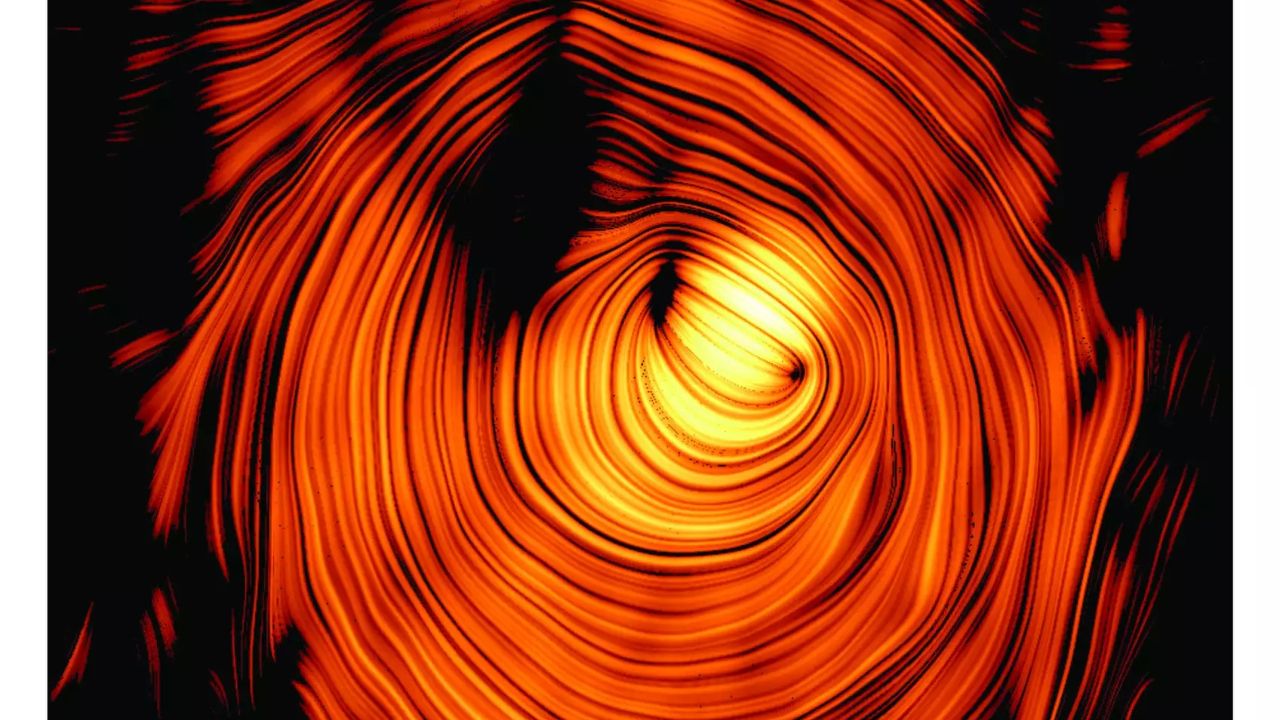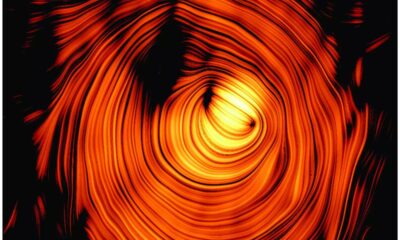Science
Astronomers Unveil Stunning Image of Blazar Resembling ‘Eye of Sauron’

Astronomers have unveiled a remarkable image of a blazar, a type of astronomical object that bears a striking resemblance to the fictional ‘Eye of Sauron’ from J.R.R. Tolkien’s *Lord of the Rings*. This discovery follows over 15 years of data collection by a powerful radio telescope, which has been monitoring a location in the cosmos approximately 1.5 billion light-years away.
The blazar, known as PKS 1424+240, is a highly energetic phenomenon that emits jets of particles moving at nearly the speed of light. These jets are directed towards Earth, creating a dazzling visual that has captivated scientists. The lead author of the study, Yuri Kovalev, who is also the principal investigator of the Multi-messenger Studies of Extragalactic Super-colliders project at the Max Planck Institute for Radio Astronomy (MPIfR), expressed his awe at the reconstructed image, stating, “When we reconstructed the image, it looked absolutely stunning.”
Understanding Blazars and Their Significance
Blazars are a specific type of quasar, which are the luminous centers of active galaxies powered by supermassive black holes. These active galactic nuclei (AGNs) emit immense amounts of electromagnetic radiation, often outshining entire galaxies. The unique orientation of blazars, with their jets pointed within 10 degrees of our line of sight, makes them appear even brighter than typical quasars.
The newly reconstructed image reveals a near-perfect toroidal magnetic field associated with the jet, which is responsible for an increase in brightness by a factor of 30 or more compared to other quasars. Jack Livingston, a co-author of the study, noted that the apparent slow movement of the jet is an optical illusion caused by projection effects.
Implications for Neutrino Research
PKS 1424+240 is not just visually striking; it is also one of the brightest sources of high-energy gamma rays and cosmic neutrinos ever recorded. Neutrinos, often referred to as “ghost particles,” are incredibly elusive and can pass through matter without interaction. The IceCube Neutrino Observatory, located near the South Pole, is credited with initially discovering this blazar due to its high levels of neutrino emissions.
Kovalev explained that this finding confirms the role of AGNs as powerful accelerators of not only electrons but also protons. This discovery is significant as it helps explain the origin of the high-energy neutrinos associated with PKS 1424+240. The study detailing these findings was published on August 12, 2023, in the journal *Astronomy & Astrophysics Letters*.
Reconstructing the image of PKS 1424+240 allows astronomers to gain deeper insights into the dynamics of these extraordinary celestial objects. Understanding how supermassive black holes accelerate particles is crucial for advancing the field of astrophysics and uncovering the mysteries of our universe.
-

 Technology3 weeks ago
Technology3 weeks agoDiscover the Top 10 Calorie Counting Apps of 2025
-

 Lifestyle4 weeks ago
Lifestyle4 weeks agoBelton Family Reunites After Daughter Survives Hill Country Floods
-

 Education4 weeks ago
Education4 weeks agoWinter Park School’s Grade Drops to C, Parents Express Concerns
-

 Technology2 weeks ago
Technology2 weeks agoHarmonic Launches AI Chatbot App to Transform Mathematical Reasoning
-

 Technology4 weeks ago
Technology4 weeks agoMeta Initiates $60B AI Data Center Expansion, Starting in Ohio
-

 Technology4 weeks ago
Technology4 weeks agoByteDance Ventures into Mixed Reality with New Headset Development
-

 Lifestyle4 weeks ago
Lifestyle4 weeks agoNew Restaurants Transform Minneapolis Dining Scene with Music and Flavor
-

 Technology3 weeks ago
Technology3 weeks agoMathieu van der Poel Withdraws from Tour de France Due to Pneumonia
-

 Technology4 weeks ago
Technology4 weeks agoRecovering a Suspended TikTok Account: A Step-by-Step Guide
-

 Technology4 weeks ago
Technology4 weeks agoGlobal Market for Air Quality Technologies to Hit $419 Billion by 2033
-

 Health4 weeks ago
Health4 weeks agoSudden Vision Loss: Warning Signs of Stroke and Dietary Solutions
-

 Technology1 week ago
Technology1 week agoDiscover How to Reverse Image Search Using ChatGPT Effortlessly










